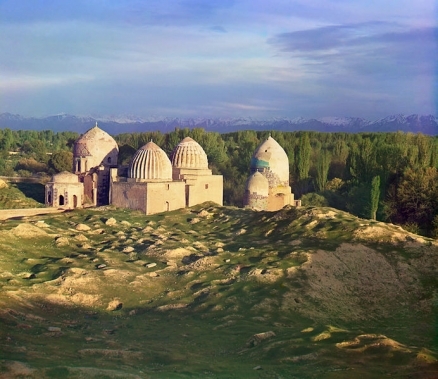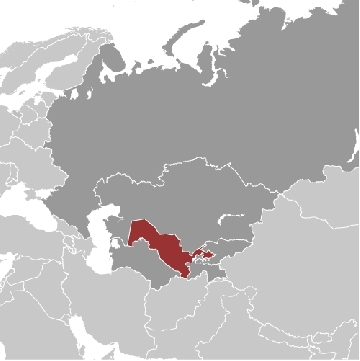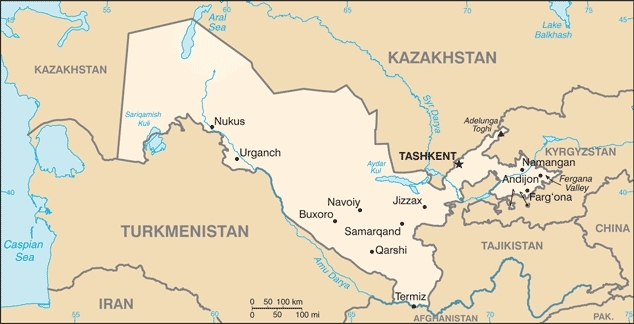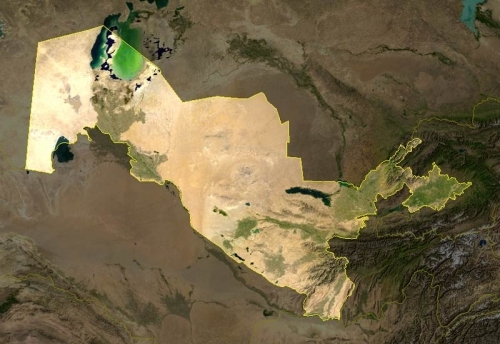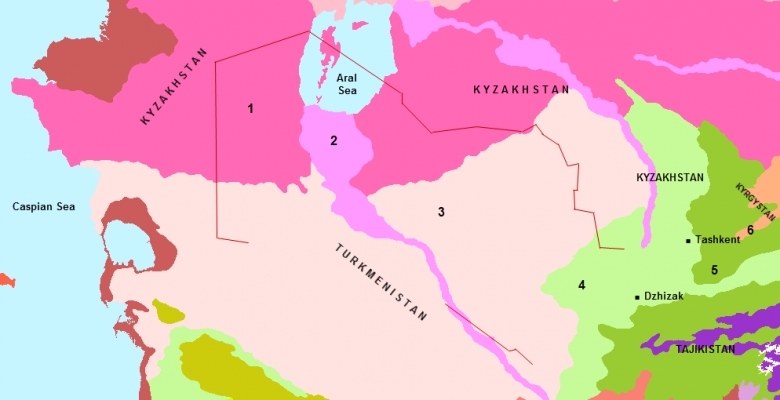Uzbekistan
Contents
Uzbekistan
Countries and Regions of the World Collection  Uzbekistan is a land-locked nation of 28 million people in central Asia north of Turkmenistan and south of Kazakhstan. Officially it is the Republic of Uzbekistan.
Uzbekistan is a land-locked nation of 28 million people in central Asia north of Turkmenistan and south of Kazakhstan. Officially it is the Republic of Uzbekistan.
More than 60% of the population lives in densely populated rural communities
Its major environmental issues include:
- shrinkage of the Aral Sea is resulting in growing concentrations of chemical pesticides and natural salts;
- these substances are then blown from the increasingly exposed lake bed and contribute to desertification;
- water pollution from industrial wastes and the heavy use of fertilizers, herbicides and pesticides is the cause of many human health disorders;
- increasing soil salination; and.
- soil contamination from buried nuclear processing and agricultural chemicals, including DDT
Prolonged drought and cotton monoculture in Uzbekistan and Turkmenistan creates water-sharing difficulties for Amu Darya river states, Field demarcation of the boundaries with Kazakhstan commenced in 2004 and border delimitation of 130 kilometers of border with Kyrgyzstan is hampered by serious disputes around enclaves and other areas.
Russia conquered the territory of present-day Uzbekistan in the late 19th century. Stiff resistance to the Red Army after the Bolshevik Revolution was eventually suppressed and a socialist republic established in 1924.
During the Soviet era, intensive production of "white gold" (cotton) and grain led to overuse of agrochemicals and the depletion of water supplies, which have left the land poisoned and the Aral Sea and certain rivers half dry.
Independent since 1991, the country seeks to gradually lessen its dependence on agriculture while developing its mineral and petroleum reserves.
Export of hydrocarbons, including natural gas and petroleum, provided about 40% of foreign exchange earnings in 2009. Other major export earners include gold and cotton.
Uzbekistan is now the world's second-largest cotton exporter and fifth largest producer; it has come under increasing international criticism for the use of child labor in its annual cotton harvest.
Current concerns include terrorism by Islamic militants, economic stagnation, and the curtailment of human rights and democratization.
Geography
Location: Central Asia, north of Turkmenistan, south of Kazakhstan
Geographic Coordinates: 41 00 N, 64 00 E
Area: 447,400 sq km (land: 425,400 sq km; water: 22,000 sq km)
Land Boundaries: 6,221 km (Afghanistan 137 km, Kazakhstan 2,203 km, Kyrgyzstan 1,099 km, Tajikistan 1,161 km, Turkmenistan 1,621 km)
Natural Hazards:
Terrain: mostly flat-to-rolling sandy desert with dunes; broad, flat intensely irrigated river valleys along course of Amu Darya, Syr Darya (Sirdaryo), and Zarafshon; Fergana Valley in east surrounded by mountainous Tajikistan and Kyrgyzstan; shrinking Aral Sea in west. The highest point is Adelunga Toghi 4,301 m and lowest point is Sariqamish Kuli -12 m.
Climate: mostly midlatitude desert, long, hot summers, mild winters; semiarid grassland in east.
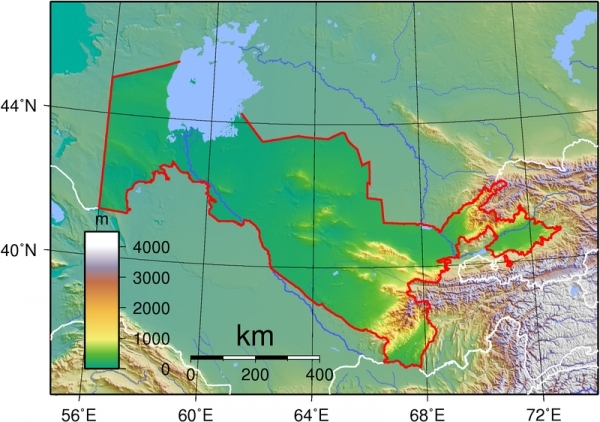
Topography of Uzbekistan. Source: Wikimedia Commons.
Satellite view of Uzbekistan. Source: NASA/Wikimedia Commons
Ecology and Biodiversity
1. Central Asian northern desert
2. Central Asian riparian woodlands
3. Central Asian southern desert
4. Alai-Western Tian Shan steppe
5. Gissaro-Alai open woodlands
6. Tian Shan foothill arid steppe
People and Society
Population: 28,394,180 (July 2012 est.)
Uzbekistan is Central Asia's most populous country. Its 28 million people, concentrated in the south and east of the country, are nearly half the region's total population. Uzbekistan had been one of the least developed republics of the Soviet Union; much of its population was engaged in cotton farming in small rural communities. The population continues to be heavily rural and dependent on farming for its livelihood. Uzbek is the predominant ethnic group. Other ethnic groups include Russian 5.5%, Tajik 5%, Kazakh 3%, Karakalpak 2.5%, and Tatar 1.5%. The nation is approximately 88% Sunni Muslim. Uzbek is the official state language; however, Russian is the de facto language for interethnic communication, including much day-to-day government and business use.
The educational system has achieved 99% literacy, and the mean amount of schooling for men is 12 years and for women is 11 years. However, due to budget constraints and other transitional problems following the collapse of the Soviet Union, texts and other school supplies, teaching methods, curricula, and educational institutions are outdated and poorly kept. Although the government is concerned about this, budgets remain tight. Similarly, in health care, life expectancy is long, but after the breakup of the Soviet Union, health care resources have declined, reducing health care quality, accessibility, and efficiency. Uzbekistan continues to enjoy a highly educated and skilled labor force.
Ethnic groups: Uzbek 80%, Russian 5.5%, Tajik 5%, Kazakh 3%, Karakalpak 2.5%, Tatar 1.5%, other 2.5% (1996 est.)
Age Structure:
0-14 years: 26.5% (male 3,817,755/female 3,635,142)
15-64 years: 68.8% (male 9,620,356/female 9,742,818)
65 years and over: 4.7% (male 560,574/female 751,955) (2011 est.)
Population Growth Rate: 0.94% (2012 est.)
Birthrate: 17.33 births/1,000 population (2012 est.)
Death Rate: 5.29 deaths/1,000 population (July 2012 est.)
Net Migration Rate: -2.65 migrant(s)/1,000 population (2012 est.)
Life Expectancy at Birth: 72.77 years
male: 69.74 years
female: 75.98 years (2012 est.)
Total Fertility Rate: 1.86 children born/woman (2012 est.)
Languages: Uzbek (official) 74.3%, Russian 14.2%, Tajik 4.4%, other 7.1%
Literacy (age 15 and up): 99.3%
Urbanization: 36% of total population (2010) growing at a rate of 1.4% annually (2010-15 est.)
History
Located in the heart of Central Asia between the Amu Darya and Syr Darya Rivers, Uzbekistan has a long and interesting heritage. The leading cities of the famous Silk Road--Samarkand, Bukhara, and Khiva--are located in Uzbekistan, and many well-known conquerors passed through the land. Alexander the Great stopped near Samarkand on his way to India in 327 B.C. and married Roxanna, daughter of a local chieftain. Conquered by Muslim Arabs in the 8th century A.D., the indigenous Samanid dynasty established an empire in the 9th century. Genghis Khan and his Mongols overran its territory in 1220. In the 1300s, Timur, known in the west as Tamerlane, built an empire with its capital at Samarkand. Uzbekistan's most noted tourist sites date from the Timurid dynasty. Later, separate Muslim city-states emerged with strong ties to Persia. In 1865, Russia occupied Tashkent and by the end of the 19th century, Russia had conquered all of Central Asia. In 1876, the Russians dissolved the Khanate of Kokand, while allowing the Khanates of Khiva and Bukhara to remain as direct protectorates. Russia placed the rest of Central Asia under colonial administration, and invested in the development of Central Asia's infrastructure, promoting cotton growing and encouraging settlement by Russian colonists.
In 1924, following the establishment of Soviet power, the Soviet Socialist Republic of Uzbekistan was founded from the territories including the Khanates of Bukhara and Khiva and portions of the Ferghana Valley that had constituted the Khanate of Kokand. During the Soviet era, Moscow used Uzbekistan for its tremendous cotton growing and natural resource potential. The extensive and inefficient irrigation used to support the former has been the main cause of shrinkage of the Aral Sea to less than a third of its original volume, making this one of the world's worst environmental disasters. Uzbekistan declared independence on September 1, 1991.
Uzbekistan has no meaningful political opposition within the country. Since 1991, virtually all prominent opponents of the government have fled or have been arrested. Five pro-government political parties hold all seats in the parliament, and independent political parties have been effectively suppressed since the early 1990s.
Pro-government media outlets (radio, TV, newspaper) dominate the media landscape and control all local reporting on political events. In the past, editors and journalists who have broached politically sensitive topics have experienced repercussions, including criminal libel charges and loss of employment, but this happens rarely today as self-censorship is the norm. The government blocks access to websites of opposition parties based outside of the country, independent media, and others critical of official government policy.
Following a 2010 speech by President Karimov on expanding the role of civil society, the Senate was granted some authority over domestic policy and some civil society actors were given more room to operate, particularly in education and women’s issues. The government also embarked on a campaign to draft new legislation that would, if enacted and adhered to, improve the operational environment for civil society. However, the government still controls most civil society activity.
Terrorism and Security
In the late 1990s, Uzbekistan began battling a low-intensity insurgency. Early in the following decade, the Islamic Movement of Uzbekistan (IMU) launched a number of small, cross-border raids. The IMU in summer 2001 allied itself with the Taliban government in Afghanistan, where most IMU fighters were then based, and subsequently engaged U.S. forces in Afghanistan. Since the fall of the Taliban government in 2001, the IMU appears to have become less active in Uzbekistan. However, terrorist bombings blamed on the IMU and splinter groups have occurred sporadically, including multiple, simultaneous 1999 attacks in Tashkent that destroyed a portion of the Ministry of Interior headquarters and narrowly missed President Karimov, and 2004 suicide bombings of the U.S. and Israeli Embassies in Tashkent. In May 2009, a suicide bombing in the city of Andijon and an assault on a border post near the town of Khanabad on the Uzbek-Kyrgyz border led the Government of Uzbekistan to temporarily increase its border security with Kyrgyzstan and in several towns in the Ferghana Valley.
In May 2005, gunmen in the city of Andijon attacked a police station, seized weapons and then stormed a prison, freeing members of a local Islamic organization accused by the government of extremism. In events whose details remain controversial, the attackers then gathered in Andijon's main square. Thousands of local residents also gathered in the square. Shooting erupted between government forces and the insurgents, and a large but undetermined number of individuals were killed. The Government of Uzbekistan, which put the death toll at 187, rejected European and U.S. calls for an independent international investigation. Unofficial death toll estimates range as high as 700 to 800. The government has not held anyone publicly accountable for the civilian casualties.
In mid-June 2010, up to 100,000 ethnic Uzbek refugees fled from Kyrgyzstan to Uzbekistan following ethnic clashes in southern Kyrgyzstan. The Government of Uzbekistan worked closely with international organizations to provide food and shelter to the refugees until they returned to Kyrgyzstan in late June.
Government
Government Type: Republic; authoritarian presidential rule, with little power outside the executive branch
The constitution of Uzbekistan provides for separation of powers, freedom of speech, and representative government. In reality, the executive holds almost all power. The judiciary lacks independence, and the legislature--which holds a few sessions each year--has limited power to shape laws. The president selects and replaces provincial governors. Islam Karimov, former First Secretary of the Central Committee of the Uzbek SSR Communist Party, was elected to a 5-year presidential term in December 1991 with 88% of the vote and was re-elected in January 2000 with 91.9% of the vote. After the parliament extended the presidential term to 7 years, President Karimov was re-elected in December 2007 with 88.1% of the vote. In December 2011, the Oliy Majlis (parliament) adopted amendments to the constitution which again reduced the presidential term to 5 years. However, this will not affect President Karimov’s current term, which is set to finish in 2014.
Parliamentary elections last took place in December 2009. While Organization for Security and Cooperation in Europe (OSCE) observers reported noticeable procedural improvements in comparison to the 2004 parliamentary elections, the OSCE did not deem the 2009 elections free and fair due to government restrictions on eligible candidates and total government control of media and campaign financing.
Capital: Tashkent (population in 2009: 2.201 million)
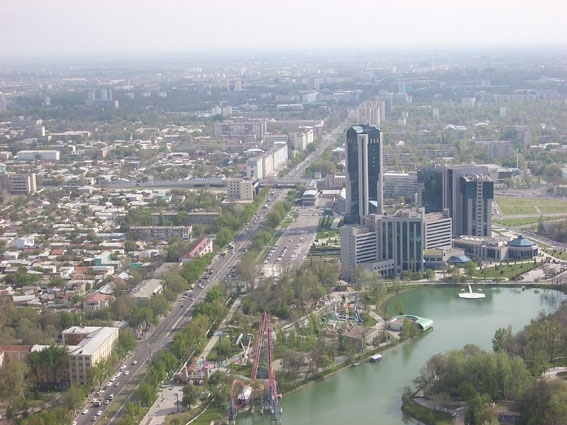
Tashkent. Source: Wikimedia Commons.
Independence Date: 1 September 1991 (from the Soviet Union)
Adminsitrative Structure: Uzbekistan is composed of 12 provinces (viloyatlar, singular - viloyat), 1 autonomous republic* (respublika), and 1 city** (shahar). Administrative divisions typically have the same names as their administrative centers (exceptions have the administrative center name following in parentheses)
1. Shahar (City): Toshkent Shahri City**
Viloyatlar (Provinces):
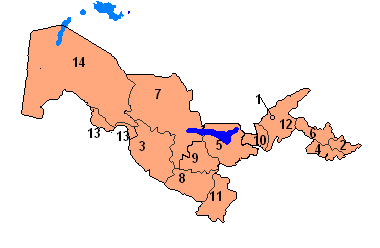 Source: Wikimedia Commons 2. Andijon Viloyati,
Source: Wikimedia Commons 2. Andijon Viloyati,
3. Buxoro Viloyati,
4. Farg'ona Viloyati,
5. Jizzax Viloyati,
6. Namangan Viloyati,
7. Navoiy Viloyati,
8. Qashqadaryo Viloyati (Qarshi),
9. Samarqand Viloyati,
10. Sirdaryo Viloyati (Guliston),
11. Surxondaryo Viloyati (Termiz),
12. Toshkent Viloyati Province,
13. Xorazm Viloyati (Urganch)
14. Respublika (Autonomous Republic): Qoraqalpog'iston Respublikasi Republic* (Nukus)
Legal System: civil law system. Uzbekistan has not submitted an International Court of Justice (ICJ) jurisdiction declaration; and, is a non-party state to the International Criminal Court (ICCt)
International Environmental Agreements
Uzbekistan is party to international environmental agreements on: Biodiversity, Climate Change, Climate Change-Kyoto Protocol, Desertification, Endangered Species, Environmental Modification, Hazardous Wastes, Ozone Layer Protection, Wetlands
Water
Total Renewable Water Resources: 72.2 cu km (2003)
Freshwater Withdrawal: 58.34 cu km/yr (5% domestic, 2% industrial, 93% agricultural)
Access to improved Drinking Water: 87% of population
See: Water profile of Uzbekistan
Agriculture
Agriculture and the agro-industrial sector contribute about 17% to Uzbekistan's GDP. Cotton is Uzbekistan's dominant crop, accounting for roughly 11% of the country's GDP in 2009. Uzbekistan also produces significant amounts of silk, wheat, fruit, and vegetables. Nearly all agriculture involves heavy irrigation. In 2008, the President signed a decree on enlargement of private farms, which has led to the redistribution of small farmers’ land in favor of large farms. Farmers and agricultural workers earn low wages, which the state seldom pays on a regular basis. In general, the government controls the agriculture sector, dictates what farms grow, and sets prices for commodities like cotton and wheat. Most farms grow wheat and cotton to meet the state order, and farmers can face losing their leased land if they do not meet state quotas.
Agricultural products: cotton, vegetables, fruits, grain; livestock
Irrigated Land: 42,230 sq km (2008)
Resources
Natural resources, minerals, and mining are integral to Uzbekistan's economy. Natural gas is Uzbekistan's most important foreign exchange earner, estimated at around 24% (2010). Gold is another important source of foreign earnings (about 7%-10% of total exports). Uzbekistan is the world's seventh-largest producer of gold, mining about 80 tons per year, and holds the fourth-largest reserves in the world. It produces oil for domestic consumption and has significant reserves of copper, lead, zinc, tungsten, and uranium.
Natural Resources: natural gas, petroleum, coal, gold, uranium, silver, copper, lead and zinc, tungsten, molybdenum
Land Use:
Economy
Following independence in September 1991, the government sought to prop up its Soviet-style command economy with subsidies and tight controls on production and prices. While aware of the need to improve the investment climate, the government still sponsors measures that often increase, not decrease, its control over business decisions.
A sharp increase in the inequality of income distribution has hurt the lower ranks of society since independence.
The economy is based primarily on agriculture and natural resource extraction. Uzbekistan is a major producer and exporter of cotton, but natural gas has replaced it as the dominant source of foreign currency earnings. It also is a major exporter of gold, uranium, and strategic minerals. (Uranium is Uzbekistan’s largest export to the U.S.) Manufacturing has become increasingly important, particularly in the automotive sector, which is aimed primarily at export to the Russian market. Since independence, the government has followed a policy of gradual transition to a free market economy but most large enterprises are still state owned or controlled.
It is difficult to accurately estimate economic growth in Uzbekistan due to unreliable government statistics. Economic growth has been strong in the past few years, but wealth is strictly held by the elite. According to the CIA World Factbook, approximately 26% of Uzbeks live below the poverty line.
The government implements a strict import substitution policy to control foreign trade and prevent capital outflow. Substantial structural reform is needed, particularly in the area of improving the investment climate for foreign investors and liberalizing the agricultural sector. Although the government has committed itself in theory to the provisions of the International Monetary Fund's (IMF) Article VIII regarding currency convertibility for current account operations, in practice firms can wait months or even years for currency conversion. Convertibility restrictions, difficulty withdrawing local currency from bank accounts, and other government measures to control economic activity, (e.g., import and export restrictions, and intermittent border closings) have constrained economic growth and led international lending organizations to suspend or scale back credits.
GDP and Employment
The International Monetary Fund estimated 2011 GDP growth at 7.1%. Unemployment and underemployment are very high, but reliable figures are difficult to obtain, as no recent credible surveying has been done. Unofficially, unemployment is estimated around 8% and underemployment around 25%. Underemployment in the agricultural sector is particularly high--which is important given the fact that 62% of the population is rural-based. Many observers believe that employment growth and real wage growth have been stagnant, given virtually no growth in output.
Labor
Literacy in Uzbekistan is almost universal, and workers are generally well-educated and well-trained. Worsening corruption in the country's education system in the past few years eroded Uzbekistan's advantage in terms of its human capital, as grades and degrees are routinely purchased. Additionally, elementary and secondary students in the remote provinces have poor access to basic education. Most local technical and managerial training does not meet international business standards, but foreign companies engaged in production report that locally hired workers learn quickly and work effectively. Uzbekistan subsidizes studies for students at Westminster University--one of a few Western-style educational institutions in Uzbekistan.
The government has implemented salary caps in an attempt to prevent firms from circumventing restrictions on the withdrawal of cash from banks. Some firms had tried in the past to evade these limits on withdrawals by inflating salaries of employees, allowing firms to withdraw more money. These salary caps prevent many foreign firms from paying their workers as much as they would like. Labor market regulations in Uzbekistan are similar to those once used in the Soviet Union, with all rights guaranteed but some rights unobserved. Unemployment and underemployment are persistent problems, and a significant number of people continue to look for jobs in Russia, Kazakhstan, the Middle East, and Southeast Asia. Business analysts estimate that a high number of Uzbek citizens are working abroad. Estimates range from lows of 3 million to highs of 5 million Uzbek citizens of working age living outside Uzbekistan. Uzbekistan signed a labor agreement with Russia in 2007 to facilitate the temporary migration of Uzbek workers and the taxation of their income.
Prices and Monetary and Fiscal Policy
Macroeconomic performance has been strong over the last 3 years and resulted in a positive trade balance. Real GDP growth was high, and official reserves continued to rise. Inflation was estimated at 13.1% in 2011. In order to combat inflation, the government has exercised strict currency controls, causing periodic shortages of cash. Reacting to the weakening of the dollar to the Euro, the government in recent years switched to the Euro for its accounting and financial management, with the hospitality sector following suit.
Gross official reserves in 2010 were estimated at $13.5 billion. In 2007, the World Bank and the UN Development Program (UNDP) provided technical assistance to reform the Central Bank and Ministry of Finance into institutions that conduct market-oriented fiscal and monetary policy. But official economic data on Uzbekistan is still often unreliable and not always available. Bank reform is very slow and inhibits the ability of citizens or private companies to obtain credit and other banking services.
Agriculture and Natural Resources
Agriculture and the agro-industrial sector contribute about 17% to Uzbekistan's GDP. Cotton is Uzbekistan's dominant crop, accounting for roughly 11% of the country's GDP in 2009. Uzbekistan also produces significant amounts of silk, wheat, fruit, and vegetables. Nearly all agriculture involves heavy irrigation. In 2008, the President signed a decree on enlargement of private farms, which has led to the redistribution of small farmers’ land in favor of large farms. Farmers and agricultural workers earn low wages, which the state seldom pays on a regular basis. In general, the government controls the agriculture sector, dictates what farms grow, and sets prices for commodities like cotton and wheat. Most farms grow wheat and cotton to meet the state order, and farmers can face losing their leased land if they do not meet state quotas.
Natural resources, minerals, and mining are integral to Uzbekistan's economy. Natural gas is Uzbekistan's most important foreign exchange earner, estimated at around 24% (2010). Gold is another important source of foreign earnings (about 7%-10% of total exports). Uzbekistan is the world's seventh-largest producer of gold, mining about 80 tons per year, and holds the fourth-largest reserves in the world. It produces oil for domestic consumption and has significant reserves of copper, lead, zinc, tungsten, and uranium.
Trade and Investment
Uzbekistan's export/import policy is based on import substitution. The highly regulated trade regime has led to both import and export declines since 1996, although imports have declined more than exports, as the government squeezed imports to maintain hard currency reserves. Draconian tariffs and sporadic border closures and crossing "fees" decrease legal imports of both consumer products and capital equipment. Uzbekistan's traditional trade partners are from the Commonwealth of Independent States (CIS), notably Russia, Ukraine, and Kazakhstan. Non-CIS partners have been increasing in importance in recent years, with the European Union, China, South Korea, Germany, Japan, and Turkey being the most active.
Uzbekistan is a member of the IMF, the World Bank, the Asian Development Bank, the Islamic Development Bank, and the European Bank for Reconstruction and Development. It has observer status at the World Trade Organization (WTO) and has publicly stated its intention to accede to the WTO. It is a member of the World Intellectual Property Organization and is a signatory to the Convention on Settlement of Investment Disputes between States and Nationals of Other States, the Paris Convention on Industrial Property, the Madrid Agreement on Trademarks Protection, and the Patent Cooperation Treaty. In 2008, Uzbekistan was again placed on the special "301" Watch List for lack of intellectual copyright protection.
Since Uzbekistan's independence, U.S. firms have invested roughly U.S. $500 million in Uzbekistan. In 2007 GM-DAT, a Korean subsidiary of GM, entered Uzbekistan when it signed a joint venture agreement with UzDaewoo to assemble Korean-manufactured cars for export and domestic sale, including Chevrolets. This plant in Asaka now produces many lines of cars under the Chevrolet nameplate for export to Russia as well as the domestic market. In 2011, General Motors opened a plant just outside Tashkent to begin producing powertrain engines. Boeing also has a longstanding relationship with the national airline of Uzbekistan, Uzbekistan Airways. Coca Cola, Baker Hughes, Nukem, Hewlett Packard, and other U.S. companies conduct small-scale operations in Uzbekistan as well. Nonetheless, some foreign investors are departing Uzbekistan because of declining investor confidence, harassment, and currency convertibility problems.
GDP: (Purchasing Power Parity): $94.04 billion (2011 est.)
GDP: (Official Exchange Rate): $43.7 billion (2011 est.)
GDP- per capita (PPP): $3,300 (2011 est.)
GDP- composition by sector:
agriculture: 21.9%
industry: 37.8%
services: 40.2% (2011 est.)
Industries: textiles, food processing, machine building, metallurgy, gold, petroleum, natural gas, chemicals
Currency: Uzbekistani soum (UZS)
